Arthur Herbert Mitson was born in Oxfordshire and then lived as a boy in London, before arriving in Chelmsford, his parents’ home town around 1905. After working for a horicultural engineers he worked at Crompton’s electrical engineers in Chelmsford and around 1911 joined the Territorial Army. After the outbreak of the war he agreed to serve overseas, marrying in Galleywood shortly before his departure. He survived the Gallipoli campaign, but was killed in action still fighting the Turks in Palestine in August 1917. His parents lived in Upper Bridge Road.
MITSON, ARTHUR HERBERT,
Sergeant, 1/5th Battalion, Essex Regiment
The initial attack to capture Gaza, known as the First Battle of Gaza, began early on 26th March 1917. The 161st Brigade, including the 1/5th Battalion of the Essex Regiment captured a hill known as Green Hill south-west of Ali el Muntar on the southern outskirts of Gaza. It was done so at a price - the Commonwealth War Graves Commission lists 117 fatalities for the battalion on 26th March 1917 plus 113 in the 1/4th Battalion of the Essex Regiment. Among them were ten Chelmsford men. The heavy casualties were mainly caused by the steady fire of three Turkish machine guns and one automatic rifle, aided by their protected position and perfect lateral filed for cross fire. Those losses were made more bitter by the decision, based on poor intelligence and communications, to withdraw Allied forces from their captured positions that night when in reality the town was their for the taking.
On 17th April 1917 a second attempt to capture Gaza, by then heavily reinforced by the Turks, was started by the Allies. Arthur’s battalion participated in the action. Some progress was made despite determined opposition and heavy casualties (many suffered by the Norfolk Regiment), but the breakthrough the Allies needed could not be achieved and Gaza remained in Turkish hands. The town would not fall to the Allies until 7th November 1917 at the Third Battle of Gaza.
During the period between the Second and Third Battles of Gaza the 1/5th Battalion of the Essex Regiment spent much of its time in trenches facing Turkish forces near to Gaza and the Mediterranean Sea, preparing for the November assault on the town. On 24th August 1917 Arthur’s battalion relieved the 2/4th Battalion of the Royal West Kent Regiment close to the sea at Marine View. Three days later they made room for the Fife and Forfar Yeomanry on the same ground. A post-war account continued:
“The Yeomanry were engaged in digging in the front line and on the night of August 29th-30th it was decided to advance the line about 500 yards to straighten out the re-entrant between ‘Jones’s Post’ and ‘Fusilier Ridge’, which was rather too distant from the enemy’s line at ‘El Arish redoubt’, to attack that stronghold from, when the time should come for that operation. The [1/5th Essex] Battalion furnished the wiring and covering parties for the work.
The bright moon made it easier for the diggers, but not so convenient for the wiring parties, who had to work on rather prominent ground, and the enemy kept up a continuous machine gun and artillery fire throughout the night, The work was constantly interrupted, and although 1,200 yards of continuous wire entanglement were put up it had to be strengthened on a subsequent night.
Four other ranks were killed, including Sergt. Mitson of A Company, and five wounded including Sergt. F. R. Wilson.”
Arthur was officially killed in action, aged 22. Today he lies in Gaza War Cemetery in Israel (grave: XXIX. G. 2). He is one of ten Chelmsford men, all from the 1/5th Battalion of the Essex Regiment who are buried there.
The Essex County Chronicle of 14th September 1917 reported:
“Sergt. A. H. Mitson, Essex Regt., is reported killed in action while serving with the Egyptian Expeditionary Force. The deceased had served two years and three months without leave. Before the war Sgt. Mitson worked at Crompton’s (under Mr. Hawkins). He went through the Dardanelles and Egyptian campaign. A pathetic fact is that Mr. and Mrs. Mitson, who live at 197 Upper Bridge Road, Chelmsford, had received a letter only on Tuesday stating that the sergeant was coming home on leave, while on the following day (Wednesday) they received official intimation that he had been killed.”
The same day’s Essex Weekly News reported:
“Sergt. A. H. Mitson, Essex regt., son of Mr. and Mrs. Arthur Mitson, of 197, Upper Bridge-rd., Chelmsford, has been reported killed in action on Aug. 29. He was 22 years of age, had served in the Dardanelles, and seen active service since July 1915. He was employed at the works of Crompton and Co. Ltd.”
One of Arthur's comrades, Private 36705 Frank Hutley, mentioned Arthur's death in his diary which the family still retains. The relevant extract appears below.
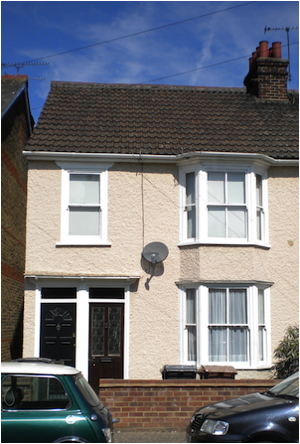
Arthur was born in Dorchester-on-Thames, Oxfordshire in 1896, the son of the turner Arthur ‘Adger’ Mitson and Lucy Mitson (nee Archer). Arthur’s father had been born in 1866; his mother in 1872, both in Chelmsford. The couple had married in 1891.
Arthur’s siblings included Eveline Lucy Mitson (1892-1896). Alice Caroline Mitson (1893-1929), Annie Mitson (born in 1897), John Leonard Mitson (1901-1980), Emily Mitson (1902-1986), Florence Rose Mitson (1909-1980) and Frank Albert Mitson (1912-1976). One other died in childhood before 1911.
The birthplaces of Arthur’s siblings suggest that his parents left Chelmsford around 1892 after the birth of their first child and went to live in Oxfordshire, before moving to Newington. London around 1896, and returning to Chelmsford around 1905.
The 1901 census found seven year-old Arthur and his family at 22 Holyoak Road in Newington. Arthur's father was a mechanical engineer. A decade later the 1911 recorded him, aged 15, working as an ‘improver tinsmith’ at a horticultural engineers, and living with his parents and five siblings at 149 Upper Bridge Road in Chelmsford (today’s number 156). His 44 year-old father was turner at an electrical engineers,
while his sister Alice was laqueress also at an electrical engineers. Arthur subsequently worked at Crompton’s electrical engineering works in Chelmsford.
Arthur lived and enlisted at Chelmsford around 1911 into the 1/5th Battalion of the Essex Regiment where he served as Private 1333 (later 250071). He later rose to the rank of serjeant. The battalion was a Territorial unit formed in 1908 with its headquarters in Market Road, Chelmsford, and it naturally contained many Chelmsford men who were to lose their lives in the war. The term ‘territorial’ indicated that the volunteers such as Arthur who served with the battalion were initially under no obligation to serve overseas, with their focus on home defence, but many like him agreed to serve abroad after the declaration of war on 4th August 1914.
At the outbreak of the war Arthur’s battalion and three other Essex Territorial battalions which formed the 161st (Essex) Brigade in the 54th (East Anglian) Division were half-way through their fortnight’s annual training at Clacton. On 3rd August 1914, the day before war was declared, Arthur’s battalion was initially ordered back to Chelmsford, but that was countermanded and the battalion marched for Dovercourt that afternoon. The following day mobilization papers were issued to all ranks and the battalion was alloted part of a pre-arranged defensive line west of Dovercourt.
On 9th August 1914 the battalion was sent to Brentwood. It did not stay there long, moving to north-east Norfolk by the end of the month, spending much of its time in training in expectation of foreign service and in defence of the eastern counties of England. In April 1915 his battalion moved to West Bergholt, before transferring to St. Alban’s in Hertfordshire the middle of the following month.
Arthur had married Rosa White n 29th May 1915 at Galleywood. At the time he was aged 20, a sergeant in the 5th Battalion of the Essex Regiment, living in St. Alban’s. his bride was the 22 year-old daughter Edward White (deceased) and lived in Galleywood.
From St. Alban’s Arthur’s battalion travelled to Devonport by train, and departed on board the S.S. Grampian on 23rd July 1915, with a somewhat depleted strength of 29 officers and 649 other ranks. Its ultimate destination was to be Gallipoli, Turkey to join the Allied forces participating in the campaign against the Turks which had started on 25th April 1915.
Stops were made at Malta and Alexandria in Egypt, before sailing to Mudros Bay on the small Greek island of Lemnos. From there the battalion sailed towards Gallipoli, transferred to flat-bottomed boats and its troops including Arthur were put ashore at A Beach, Suvla Bay on 9th August 1915 to supplement forces that had landed there over the previous three days.
The 1/5th Battalion of the Essex Regiment had a difficult time in Gallipoli, making little progress against the Turkish Army. With the failure of the Gallipoli campaign it was withdrawn from Anzac Cove on 4th December 1915; its strength reduced by then to 13 officers and 141 other ranks, of whom six officers and 100 other ranks had served throughout the 17 weeks in Gallipoli. I
Following its withdrawal from Gallipoli the battalion landed in Alexandria, Egypt on 17th December 1915. On 28th December 1915 it was sent to El Hamam, Egypt where it formed part of the Western Frontier Force. On 5th March 1916 the battalion left for Mena Camp near Cairo, Egypt, before it was moved eastwards to protect the Suez Canal and its vital supply route, in an area known as the Southern Canal Section, from Turkish attacks across the Sinai Peninsula. The battalion remained there until January 1917.
By early 1917 the Turkish forces that had been threatening Egypt were being steadily driven back across the Sinai Peninsular towards Palestine by the advancing Allies. The 1/5th Battalion of the Essex Regiment spent most of February crossing the Peninsular and by late March 1917 was close to the Palestine town of Gaza, then still held by the Turks. The town was of strategic importance and had to be captured by the Allies if they were to succeed in their objective of driving the Turkish army northwards out of Palestine and thus isolating other Turkish forces in Mesopotamia and the Arabian Peninsular.
Arthur is commemorated on the Civic Centre Memorial, Chelmsford, and the Moulsham Parish Memorial, St John’s Church, Moulsham. He was entitled to the 1914-15 Star, British War Medal, and Victory Medal.
The 1918 register of electors listed Arthur’s parents living in a flat at 197 Upper Bridge Road, Chelmsford (pictured).
On 30th August 1918 the Essex County Chronicle carried the following in memoriam announcement:
“Mitson. - In loving memory of our dear son, Sergt. A. Mitson, 1/5th Essex Regt., who was killed in Egypt, Aug 29th, 1917.
God takes our loved ones from our homes. But never from our hearts.
From his loving Father, Mother, Sisters and Brothers - 197 Upper Bridge Road, Chelmsford.”
Arthur’s father died in 1937, aged 71. His mother died in 1954.
220608
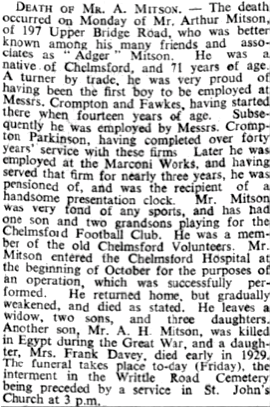
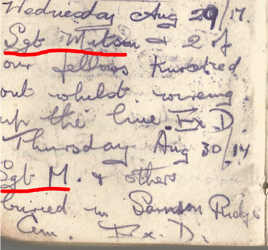
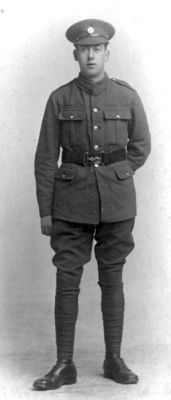
Right: Frank Hutley, who recorded the death of his comrade Sgt, Arthur Mitson. (courtesy of his great grandson Jake Hutley)
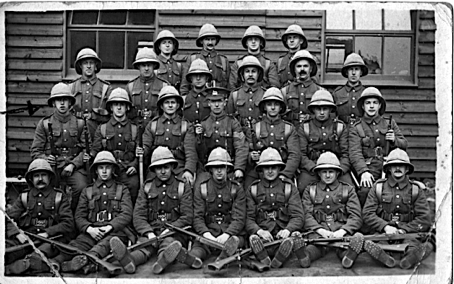
Left; Group photograph including Arthur's comrade, Frank Hutley (2nd row back, far left). Conceivably Arthur could also be in this photograph.